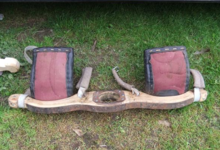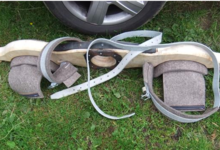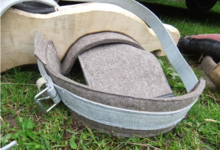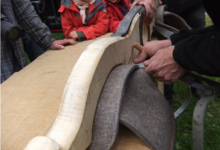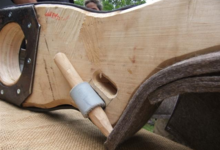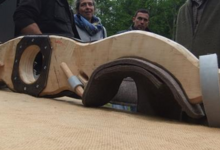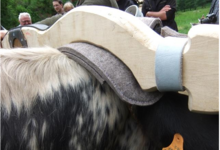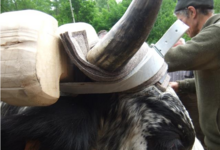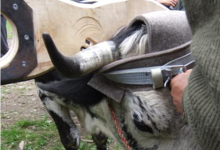9. Int. Ox Drovers' Meeting at the Écomusée d'Alsace
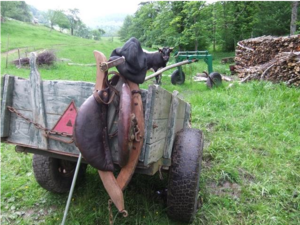
The Ecomusée d’Alsace near Ungersheim in France celebrated its 30th anniversary and the festivities were launched Thursday, June 28th, with a procession headed by two of Phillippe Kuhlmann’s oxen, Marco and Bachi, pulling a cart, a two-horse team in front of a flatbed wagon, followed by two old-timer tractors (a Lanz-Bulldog and an Algaier), wending their way from the Upper Rhine General Council in Colmar the 38 kilometers to the Ecomusée. This unusual caravan was warmly set on its way by Charles Buttner, present Haut-Rhine Council General President, and Henri Goetschy, former president. The director of the Ecomusée, Eric Jacob, noted that it was a symbolic procession uniting the three main partners responsible for the museum: the Friends’ Association, represented by President Jacques Rumpler, who joined in the long walk, Jean-Claude Mensch, the Mayor of Ungersheim, whose town has given every possible support and encouragement to the Ecomusée since its beginnings, and Monsieur Buttner, President of the Upper-Rhine General Council.

The Ecomusée figured in daily reports in the press and the regional magazine “L’Alsace” devoted a special issue to the museum's history with numerous illustrations of animals working as well as those kept regularly in the museum’s village. The events from Friday through Sunday were followed by both the public and the ox drovers, who participated in open sessions in the museum and also “private” lessons by Phillippe Kuhlmann. Phillippe and Anne-Catherine invited us to their farm in Soultzeren, in the Alsatian highlands – a total change from the atmosphere and farming conditions at the Ecomusée in the plains – for the Friday working day. They run their farm entirely on animal draught and keep some forty cattle year round to sell. On top of this Phillippe trains a few of the young animals to work and markets them, so that the turnover is fast. He hires his teams out for vineyard and logging tasks, as well as the usual round of work at the farm, using the small, hardy Vosges breed particularly suited to this area and the production of milk for the renowned Munster cheese.

The breed’s coat is usually spotted, black and white, but can run from nearly all black or white, with rare examples of brown and white, one of which Phillippe harnessed for us. He cherishes the quality of their black hooves, extremely hard and resistant, as well as necessitating very little care, which makes them an outstanding working breed and national policy is indeed supportive to keep this breed's numbers up sufficiently. Anne-Catherine and Phillippe process their own cheeses, both from cows and goats, as well as adding to income through rental of their holiday chalet rooms, so it is a multi-activity farm, as are many small-holdings in France. We were joined there by many of their friends and neighbours: the musicians who played including Anne-Catherine and her alpine horn, as well as the saddler Jean-Claude Mann and the builder of Phillippe’s new machine.
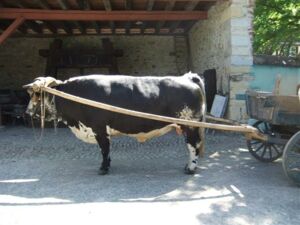
Phillippe had a special program for us with a surprise – it was the very first time he was trying out a one-beam forklift-pusher made for him by a mechanic neighbor to be able to transport hay bales and other heavy, compact loads. The basic idea was to allow the animals to either pull or – as for the Gallo-Roman vallus* (see endnote) – to push, switching by simply turning over the pole. This would give the device a considerable momentum moving forward and also allow Phillippe to use it for a snow shovel, most practical at their altitude. He also hopes to replace the presently hand-cranking mechanism with a device worked directly by the oxen.
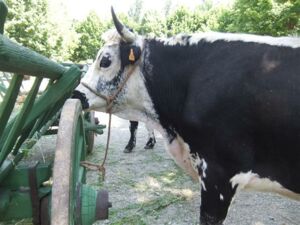
All of this is possible with the double head yoke only. The experiment indicated that there was one articulation too many and the resulting rotation meant this needed to be eliminated. In any case, the pushing effort made by the animals was very revealing, as slightly too much power from the left ox meant a distinct veer to the right, but the animals eventually managed to cope during their work day. The onlookers were hardly idle, many of them participating in all the manoeuvres and two of them immediately constructing a second, straight and simple beam from some logged wood near the farmhouse, so it was possible to try this out as well.
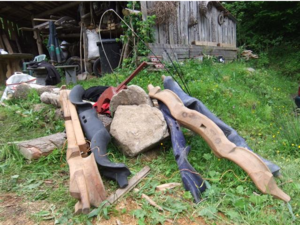
The day’s experimentation was discussed again at the Ecomusée as one of the most salient points in our conversations: only if a farmer is willing (and stiff-necked enough) to forego using a tractor will s/he be forced to do some ingenious thinking in order to come up with new devices suited to animal draught, especially for cattle, which have been so sorely ignored. In fact, since the late 1960s and early 1970s in Western Europe, when the numbers of draught animals at work plunged to near zero, all the ingenuity that could have been dedicated to their working gear was channeled off to mechanization. There was general agreement that much more action is necessary and that the network can help promote research, as has already been done at the CFPPA Montmorillon. As was emphasized, there is a lot of information in documents of the 19th and first half of the 20th century that must not be overlooked, so please keep your eyes open for any and all documentations of experiments with both harnesses and equipment.
One of the other highlights of the day was to have Phillippe guide us through a successive series of head yokes, from the older Alsatian double headyoke with bulky, cushioned head pads, requiring considerable protection for the ears, on to the new and longer versions he had constructed, that were successful, then on to the same type of yoke with the cushioning attached and finally, to the very latest thick felt version. These pads are likewise entirely attached to the yoke, straps and buckles included, and provide an impressive speeding up of yoking time. Phillippe also had the yokes reinforced by metal bars to strengthen the area of the beam hole, which is vulnerable to wear and breakage.
We all want to express our heartfelt thanks to Phillippe and Anne-Catherine for this remarkable working day!
You can visit them online at http://lechaletvosgien.free.fr and why not go for a stay?
Contact:
A.C. & Ph. KUHLMANN
Chemin du Londenbach
68140 SOULTZEREN
Tel. 03 89 77 44 46 - Cellphone. 06 86 26 09 33
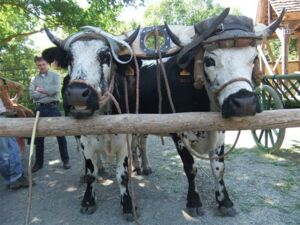
If you read French or just enjoy looking at the photographs of recent events, be sure to check out Michel Nioulou – who attended the working day and Saturday events at the Ecomusée with us – at his blog for working cattle: http://attelagesbovinsdaujourdhui.unblog.fr/
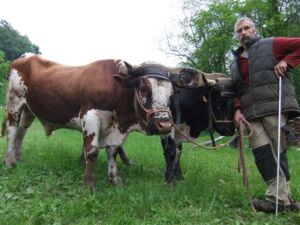
We spent Saturday and Sunday at the Ecomusée d’Alsace, thoroughly enjoying their generous hospitality and noting that the director as well as many of the volunteers and animators speak German, so that discussions were especially rich. Saturday was a major day at the museum and we met in the morning to get the oxen ready for their participation in the celebrations, which included pulling various carts and wagons. They also had to present themselves for the live coverage on local television. Phillippe had brought his Marco and Bachi, four and a half years old, and still slightly tired from their nearly-forty-km walk unshod on Thursday. Phillippe showed us that their hooves were not all too worn, as a cue the telltale “black line” indicating there was still plenty of room to go. He made a point of having walked them on softer ground whenever that was possible in their procession through the villages along the way. André Kammerer brought his own six-year-old Vosges oxen along to hitch up, along with one other ox on loan to the museum.
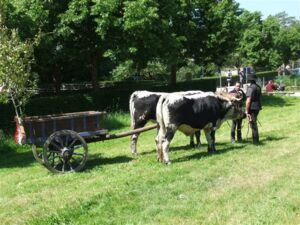
After their appearance on television the ox drovers went off into the Ecomusée's woods for a “private lesson” in logging under quite difficult conditions – without much space on the twisting lane, there were a lot of challenges, including the character of the two animals of Phillippe. Marco, the nigh ox, was not as courageous in hardships as the more experienced Bachi, and the latter was irritated over having to do most of the work, so he thrust sporadically forward to get it over with, which was no help. The heavy, wet trunk got caught in some tight places and the only solution was to unhitch and start over again several times. It is in these situations were you can really see both the determination and deep patience Phillippe offers to keep the animals motivated through rough spots, and it is this time when we learn the most. The log was successfully carted off to the saw mill on a logging wagon, where ox draught also put it in position for the sawing demonstration.
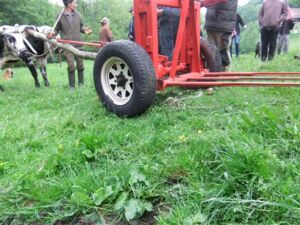
At the end of Saturday's outdoor work, when we ox drovers** met in the volunteers’ kitchen for our discussion, both the Director, Eric Jacob, and the President of the Ecomusée Friends’ Association, Jacques Rumpler, came by to say that the museum would be honored to offer its premises as a venue, a future home for all European ox drovers to meet in. We discussed a strategic plan*** (see below) to bring cattle draught, as well as working animals in general and the equipment innovations they need, to the forefront of a discussion in sustainable agriculture. The conversation included ways to improve efficiency of our meetings in promoting communication of these intangible skills and skillholders and how to raise the awareness of the spectrum of animal-power users, from what we all respectfully call “hobby” farmers to people like Anne-Catherine and Phillippe at the other end, working entirely with animal draught. This also includes farmers like Christine Arbeit and Jo Durand in the Loire-Atlantique, André Kammerer in Alsace, people like Michaela and Gerhard Döring who have undertaken self-sustained farming with their Grauvieh (grey Raetian cattle), staff from museums, historical sites or theme parks like Richard Dalton or Laurent Martin, who do part of their landscape maintenance or farm with animal power, loggers, many of whom use horses and cattle to make a living, and Anne Wiltafsky, who does hands-on research in cattle behavior, even combining work with art in her Cow School (http://www.kuhschule.com/)

The German and French working oxen websites should at the very least provide links to each other, announce meeting dates, workshops, animals for sale, etc., and we hope thus may be able to organize still better coordinated encounters on an international basis. Our English participant, Richard Dalton, is going to consider the possibilities for getting a parallel English-language website set up. He will also update us on discussions of plans for training in animal draught outside the already very extensive programs for logging set up by the British Horse Loggers (http://www.britishhorseloggers.org/index.html). By the way, we have not forgotten that three quarters of all farmers worldwide still use draught animals in their everyday lives.
Needless to say our evenings went on late, while we got out memory sticks and looked at pictures or films on our laptops. One of the participants, Solène Gaudin, a student at the adult education school (a “CFPPA”) in Montmorillon (http://www.eplea-montmorillon.org/spip.php?breve36) near Poitiers told us about the training program in animal draught (six months) including cattle (five days) run by Manu Fleurentdidier, who was with us for the entire weekend. We might hope for something similar in Germany. These, and the many more new contacts alone, were well worth the trip to Alsace!
We might add as heartening news that the French Minister of Agriculture, Stéphane Le Foll, announced earlier this year that he intended to put his shoulders behind the promotion of working horses, so we hope he will be thinking out of the box, including draught cattle. The FECTU (European federation for promotion of working horses, http://www.fectu.org/) has just published – in German, French and English – an expert downloadable booklet on “Work Horses, an alternative for the future” (click "Services", then "pdf-download") and notes that their ambit covers all working animals, so we have long since included them in our network. Our overseas contacts are expanding and now include enthusiastic ox drovers working in museums or historical sites who are members of the ALHFAM (Association for living history, farming and agriculture museums, http://www.alhfam.org/?cat_id=128&nav_tree=119,128).
*As Phillippe and Cozette pointed out, there is nothing very new about having animals (oxen and mules) push a harvesting machine. Check out the Gallo-Roman “vallus” in Google images and you’ll see! This subject has been covered technically in Georges Raepsaet’s Attelages et techniques de transport dans le monde gréco-romain, Brussels: Livre Timperman, 2002 (among others).
**present for the discussion session at the Ecomusée d’Alsace: Christine Arbeit, Jo Durand, Mélusine Bailloux (Farmers in the Loire-Atlantique); Jörg Bremond (pilot of the German Working Cattle Group « Arbeitsgruppe Rinderanspannung », http://www.zugrinder.de/) ; Richard Dalton (Gressenhall Farm & Workhouse, Dereham, Norfolk, UK); Michaela and Gerhard Döring (German Working Cattle Group); Manu Fleurentdidier (instructor at the CFPPA Montmorillon); Lilian Frey (Kuhschule); Solène Gaudin (student at the CFPPA Montmorillon); Axel Göbel (German Working Cattle Group); Cozette Griffin-Kremer (international network); Eric Jacob (Director Ecomusee d’Alsace); André Kammerer ((French working group); François Kiesler (Ecomusée d’Alsace animator, retired); Phillippe Kuhlmann (host); Laurent Martin (French working group); Astrid Masson (Domäne Dahlem, http://www.domaene-dahlem.de/); Jacques Rumpler (President, Ecomusée Friends’ Association); Thomas Schultze (German Cattle Working Group)
*** Strategic plan in worldwide network – WIDE OPEN FOR DISCUSSION / Please contribute!
2014-2018 Remind the public that agriculture and stockbreeding were as essential to the war effort as industrial production, shipping, and aeronautical, transport and weapons innovations
2014-2016 Strive for “communication convergence” – the maximum connectivity among the actors
2014 Found an internationally composed expert committee to lay out the standards of competence required to work with draught cattle, to seek out and officially recognize the most highly qualified handlers, and define their duties
2015 Acquire for these handlers the status of living treasure, as per definition by UNESCO for the EU or equivalent in other countries or groupings of nations, and hence financing for transmitting their expertise
Identify museums already maintaining a high level of expertise in animal handling, as well as those willing and capable of stepping up onto the platform
Develop a pan-European program for educating handlers, prioritarily in museums, and extend this to
2016 A worldwide program that would raise awareness of the value of animal energy and those who practice it in cognizance of the best animal welfare policies possible in their time and place
2017-2023 Promote the consequences of educating more expert handlers by creating jobs for them in cities, peri-urban areas and underwriting the creation of farms utilizing animal power. (The last requires a separate strategic plan.)
Astrid Masson, with translation and added notes by Cozette Griffin-Kremer (griffin.kremer@wanadoo.fr)

